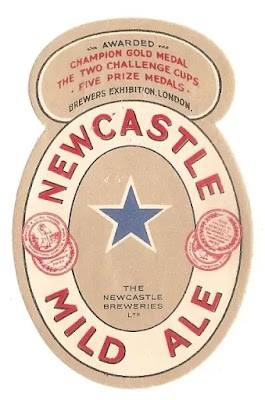Well, that is sort of the reason. Because, without the distraction of meeting people, All would be done and dusted with my latest book. The one I've been working on for five years.
Tomorrow. Tomorrow. I'll finally get the bugger published. It will be a special day. For me, if no-one else.
I’m afraid that I have no details of any specific provincial Brown Ales. As Whitbread’s spies didn’t get out much during the war. No beers called Brown Ale appear in the brewing records I have, either.
Hence the very sparse table.
Luckily, the two beers do encompass the two main types of Brown Ale. Which for simplicity’s sake I call Strong Brown Ale and Weak Brown Ale. I’m reluctant to call the former Northern Brown Ale as there were beers in that style brewed in London. Whitbread Double Brown, for example.
The Newkie Brown was pretty highly attenuated. Was that to compensate for the fall on gravity? As you’ll see later, post-war versions had a higher OG but lower degree of attenuation.
Quite a contrast is the Dam Smith’s beer. Looking more like a Mild. Which is what it probably was. Perhaps primed a little differently. Not so great attenuation means it was probably fairly sweet.
| Provincial Brown Ale during WW II | |||||||
| Year | Brewer | Beer | Price per pint (d) | OG | FG | ABV | App. Atten-uation |
| 1940 | Newcastle Breweries | Brown Ale | 1048.5 | 1008.5 | 5.21 | 82.47% | |
| 1942 | Samuel Smith | Taddy's Nut Brown Ale | 10 | 1033.4 | 1009.8 | 3.06 | 70.66% |
| Sources: | |||||||
| Thomas Usher Gravity Book held at the Scottish Brewing Archive, document number TU/6/11. | |||||||
| Whitbread Gravity book held at the London Metropolitan Archives, document number LMA/4453/D/02/001. | |||||||
This is an excerpt from my recently-released Blitzkrieg!, the definitive book on brewing during WW II.
The second volume contains the recipes. But not just that. There are also overviews of some of the breweries covered, showing their beers at the start and the end of the conflict.
Buy one now and be the envy of your friends!













































































1 comment:
Agreed Ron very few beers have regional differences bar Dunkels with Dunkels from Franconia tending to being drier. One such example of this bollocks in beer being Cork stout (more chocolate) and Dublin stout (more coffee) this was true fifty years ago when Beamish,Murphy’s and Guinness were the last breweries making stout in Ireland. These days the trend is being bucked three of Porterhouse’s single stouts are not as coffee tinged as xxxx stout.
Oscar
Post a Comment